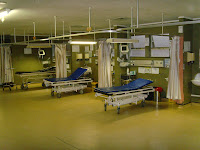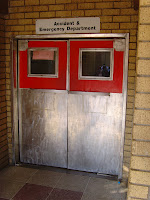I've reached the halfway point, having just finished my 3rd week of work in the Accident & Emergency Department (A&E). It's hard to believe I'll only be here for three more weeks, but I think it's high time I post something about my work here in Botswana! (By the way, this is Dan, not Amy.)
First of all, my schedule is pretty nice. There are basically two shifts covered by the EM faculty here during the week: 7:30 a.m. to 2:30 p.m. and 2:00 p.m. to 9:30 p.m. I work three or four shifts per week and none on the weekends! The primary focus has become supervising and teaching EM residents ("registrars" in the master of medicine (MMed) - emergency medicine program) and medical students. Most of the work in A&E is done by medical officers (physicians without formal specialty training) employed by the hospital (ministry of health). The university employs the EM faculty (currently only 3 docs from the U.S. and Australia) and the registrars. The EM specialist faculty are generally available by phone when not working clinically in the ED.
 |
| Left: Empty board = slow morning Right: XRays on the PACS computers (some days it works, some days it doesn't) |
Around 30,000 patients per year are seen in A&E, so that's 80-90 patients per day on average. Most of them are seen between the hours of 11 a.m. and midnight. It's not uncommon for A&E to be empty, or nearly so, from the early morning hours until about 10 a.m. Things also pick up at month's end when people get paid.
There are 10 bays in our ED and a two-bed resuscitation room. Relatively stable patients waiting for tests or admission get moved to one of 7 "corridor" slots in either a bed or a chair. Some patients who are suspected to have TB are kept in the "isolation" room next to the triage area for evaluation. Most of the bays have a Philips monitors & wall oxygen units. The university owns an ultrasound machine (SonoSite M-Turbo) that is kept in A&E. You can also request an ultrasound with report from radiology. Plain X-rays are available, but can take hours, even if you request a portable film. There is a CT scanner that has been in and out of commission (supposedly because of problems with the doors containing its radiation) that can be used for head CT from A&E. Apparently if you want an abdominal CT, the surgeon has to order it. Labs are available but the reporting time is highly variable.
 |
| It won't be long 'til these bays are full. |
 |
| One side of "Resus". |
Medication availability is somewhat variable (like in the U.S. these days!). We have some antibiotics, but not a comprehensive selection. It seems like everyone either gets oral amoxicillin or IV cefotaxime. It's on an open shelf in our med room alongside IV diazepam and ketamine. Apparently normal saline solution is on short supply, or not available, but currently there is Ringer's Lactate and dextrose containing IV fluids.
Around town there are plenty of fancy new buildings and shopping centers (this is not a remote part of Africa) and yet the hospital (and entire health care system) is lacking basic equipment, supplies and infrastructure.
 |
| The new health sciences building at the university. |





Wow, Dan! The difference between the hospital and the college is shocking!
ReplyDelete